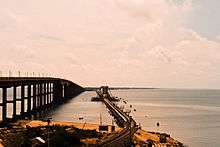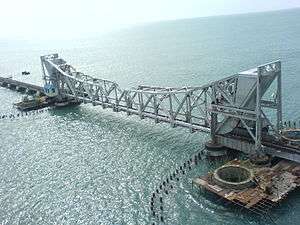Pamban Bridge
| Pamban Bridge பாம்பன் பாலம் | |
|---|---|
 Pamban bridge | |
| Coordinates | 9°16′57.25″N 79°12′5.91″E / 9.2825694°N 79.2016417°ECoordinates: 9°16′57.25″N 79°12′5.91″E / 9.2825694°N 79.2016417°E |
| Carries | Rail |
| Locale | Rameswaram, Tamil Nadu, India |
| Owner | Indian Railways |
| Characteristics | |
| Total length | 6,776 feet (2,065 m) |
| Number of spans | 143 |
| Rail characteristics | |
| No. of tracks | 1 |
| Track gauge | broad gauge |
| History | |
| Construction begin | 1911 |
| Construction end | 1914 |
| Opened | 1915 |
Pamban Bridge is a railway bridge which connects the town of Rameswaram on Pamban Island to mainland India. Opened on 24 February 1914, it was India's first sea bridge, and was the longest sea bridge in India until the opening of the Bandra-Worli Sea Link in 2010. The rail bridge is, for the most part, a conventional bridge resting on concrete piers, but has a double-leaf bascule section midway, which can be raised to let ships and barges pass through.
Location
The bridge spans a 2 km strait between the Indian mainland and Pamban island. The mainland end of the bridge is located at 9°16′56.70″N 79°11′20.12″E / 9.2824167°N 79.1889222°E. The bridge is located in the world's second most corrosive environment after Florida, making its maintenance a challenging job. The location is also a cyclone-prone high wind velocity zone.[1]
Design

The railway bridge is located 12.5 metres (41 ft) above sea level and is 6,776 ft (2,065 m) long.[1] The bridge consists of 143 piers and has a double-leaf bascule section with a Scherzer rolling type lift span that can be raised to let ships pass. Each half of the lifting span weighs 415 tonnes (457 tons).[2] The two leaves of the bridge are opened manually using levers.[1]
Planning and Construction
Plans for a bridge to connect to mainland was suggested in 1870 as the British Administration sought ways to increase trade with Ceylon.[3] The construction began in August 1911 and was opened on 24 February 1914.[4] The adjacent road bridge was opened in 1988.[3]
Maintenance
The bridge was damaged during the 1964 Rameswaram cyclone and required repair work. [5] Strengthening work was carried out on the bridge under the supervision of E. Sreedharan in 2009 to enable it to carry goods trains.[6][7] On 13 January 2013, the bridge required repair work to the piers after suffering minor damage from a naval barge.[8][9] In 2016, the Ministry of Railways sanctioned ₹25 crore (US$3.7 million) to replace the existing 65.23 metres (214.0 ft) long rolling type span with a 66 metres (217 ft) long single truss span which could be opened automatically.[10]
Railway
The railway bridge carried metre gauge trains connecting Mandapam on mainland India to Pamban. Indian Railways upgraded the bridge to carry broad gauge trains as part of Project Unigauge and the work was completed on 12 August 2007.[3] From Pamban, the railway line bifurcated, one line towards Rameshwaram about 6.25 miles (10.06 km) up and another branch line of 15 miles (24 km) terminating at Dhanushkodi.[11] Boat mail express runs from Chennai Egmore to Rameswaram. The train ran upto Dhanushkodi till 1964 when the metre-gauge branch line from Pamban to Dhanushkodi was destroyed during the 1964 Dhanushkodi cyclone.[12]
Accidents
On 23 December 1964, an estimated 7.6 m (25 ft) storm surge struck the island, overturning the Pamban-Dhanuskodi passenger train killing all 150 passengers on board.[13] On 13 January 2013, the bridge suffered minor damage when a naval barge drifted into it.[14]
See also
- Bandra–Worli Sea Link
- List of longest bridges in the world
- List of longest bridges above water in India
References
- 1 2 3 T.E., Raja Simhan (21 November 2003). "Pamban Bridge to be pulled down for gauge conversion". The Hindu. Retrieved 7 May 2015.
- ↑ Sri Raman, Papri (11 August 2007). "Bridge of memories - and to Rameswaram - reopens". Hindustan Times.
- 1 2 3 "Pamban bridge: 10 awesome facts about India's first sea bridge". The Economic Times.
- ↑ Lalvani, Kartar (2016). The Making of India: The Untold Story of British Enterprise. Bloomsbury Publishing. ISBN 978-14-7292-483-4.
- ↑ The Story of The Deities and The Temples in Southern Indian Peninsula. Trilochan Dash. p. 178.
- ↑ "Delhi's Subway Builder". Forbes. 1 May 2009.
- ↑ "Strengthening of Pamban Railway Bridge". The Hindu. 17 July 2010.
- ↑ "Ship collides into century-old rail bridge". NDTV. 13 January 2013.
- ↑ "Repair work on Pamban bridge fast progressing". The Hindu. 16 January 2013.
- ↑ "Principal Chief Engineer inspects Pamban rail bridge". The Hindu. 26 February 2016.
- ↑ Jethwa, Raja Pawan (2007). "Section II: Mileage wise available Details of Railway lines laid". Shree Kutch Gurjar Kshatriya Samaj: A brief History & Glory of our fore-fathers. pp. 63–70.
- ↑ Jaishankar, C (17 July 2006). "Their sentiment to metre gauge train is unfathomable". The Hindu.
- ↑ Jaishankar, C. (24 December 2005). "Memory of the disaster still lingers". The Hindu.
- ↑ "Ship collides into century-old rail bridge". NDTV. 13 January 2013.
External links
| Wikimedia Commons has media related to Pamban Bridge. |
| Wikimedia Commons has media related to Annai Indira Gandhi Road Bridge. |